Challenges for Energy Transition in Poverty-Ridden Regions—The Case of Rural Mixteca, Mexico
Abstract
1. Introduction
2. Mixteca-Puebla: Characterization of the Area
3. Methodology: Cross-Impact Balance Analysis
- (1)
- Defining the context. A selection of descriptors, which characterize the energy system of Mixteca, needed to be defined and understood as a socio-technical system. The selected descriptors represent social and cultural aspects, i.e., on emigration, ethnic identification, education, community organization, and women’s empowerment, and political features, such as governance and uncertainties, policies, and the legal system. Furthermore, economic facets consisting of income, wealth distribution, and financial markets are addressed. Environmental factors such as climate change and its impacts on the population are also included under the model input data (Table 1).
- (2)
- Identifying the future system-states. To address possible trends and uncertainties, a set of two to four alternative future states were defined and assigned to each descriptor. These future states were selected through the group of experts involved. The selected descriptors and their alternative futures for the region under review are summarized in Table 1.
- (3)
- Identifying the interdependencies and building up the cross-impact matrix (CIM). The inter-relationships between descriptors were valued using an integer, ranging, in our case, from −3 to +3, with −3 indicating a strong trade-off relationship, whereas +3 indicated a strong supporting relationship. The quantification of the interdependencies was performed with the assistance of the experts. An example of this evaluation is shown in Figure 4.
- (4)
- Identification and analysis of the scenarios. Using ScenarioWizard v4.31 (it can be downloaded from: www.cross-impact.org), consistent combinations of descriptor-states were identified. Each consistent combination of all descriptors described a scenario (Figure 5). The scenarios were analyzed to identify relevant driving forces and the political, societal, economic, and technological conditions of possible future developments (see Section 4).
4. Storylines
4.1. Driving Forces
4.2. Characterization of Clusters
4.3. Cluster 1, Synopsis: “Back to the XIX Century”
4.4. Cluster 2, Synopsis: “Hope for a Better Future”
4.5. Comparative Summary
5. Discussion
6. Conclusions
Supplementary Materials
Author Contributions
Funding
Data Availability Statement
Acknowledgments
Conflicts of Interest
Appendix A

References
- Scholz, R.W.; Bartelsman, E.J.; Diefenbach, S.; Franke, L.; Grunwald, A.; Helbing, D.; Hill, R.; Hilty, L.; Höjer, M.; Klauser, S. Unintended side effects of the digital transition: European scientists’ messages from a proposition-based expert round table. Sustainability 2018, 10, 2001. [Google Scholar] [CrossRef]
- Grunwald, A. Diverging pathways to overcoming the environmental crisis: A critique of eco-modernism from a technology assessment perspective. J. Clean. Prod. 2018, 197, 1854–1862. [Google Scholar] [CrossRef]
- Orehounig, K.; Evins, R.; Dorer, V. Integration of decentralized energy systems in neighbourhoods using the energy hub approach. Appl. Energy 2015, 154, 277–289. [Google Scholar] [CrossRef]
- Østergaard, P.A. Reviewing optimisation criteria for energy systems analyses of renewable energy integration. Energy 2009, 34, 1236–1245. [Google Scholar] [CrossRef]
- Vidal-Amaro, J.J.; Østergaard, P.A.; Sheinbaum-Pardo, C. Optimal energy mix for transitioning from fossil fuels to renewable energy sources—The case of the Mexican electricity system. Appl. Energy 2015, 150, 80–96. [Google Scholar] [CrossRef]
- Terrapon-Pfaff, J.; Dienst, C.; König, J.; Ortiz, W. A cross-sectional review: Impacts and sustainability of small-scale renewable energy projects in developing countries. Renew. Sustain. Energy Rev. 2014, 40, 1–10. [Google Scholar] [CrossRef]
- Dewald, U.; Grunwald, A.; Poganietz, W.-R.; Schippl, J. Die energiewende als sozio-technische transformation von der analyse zur gestaltung. In Energiewende: Eine Sozialwissenschaftliche Einführung; Radtke, J., Canzler, W., Eds.; Springer Fachmedien Wiesbaden: Berlin/Heidelberg, Germany, 2019; pp. 319–352. [Google Scholar] [CrossRef]
- Miller, C.A.; Iles, A.; Jones, C.F. The social dimensions of energy transitions. Sci. Cult. 2013, 22, 135–148. [Google Scholar] [CrossRef]
- Geels, F.W. From sectoral systems of innovation to socio-technical systems: Insights about dynamics and change from sociology and institutional theory. Res. Policy 2004, 33, 897–920. [Google Scholar] [CrossRef]
- Pastukhova, M.; Westphal, K. Governing the global energy transformation. In The Geopolitics of the Global Energy Transition; Hafner, M., Tagliapietra, S., Eds.; Springer International Publishing: Berlin/Heidelberg, Germany, 2020; pp. 341–364. [Google Scholar] [CrossRef]
- Bartiaux, F.; Maretti, M.; Cartone, A.; Biermann, P.; Krasteva, V. Sustainable energy transitions and social inequalities in energy access: A relational comparison of capabilities in three European countries. Glob. Transit. 2019, 1, 226–240. [Google Scholar] [CrossRef]
- Bradshaw, M. Global energy dilemmas: A geographical perspective. Geogr. J. 2010, 176, 275–290. [Google Scholar] [CrossRef]
- Hulme, M. (Still) Disagreeing about climate change: Which way forward. J. Relig. Sci. Spec. Issue 2015, 50, 893–905. [Google Scholar] [CrossRef]
- Vãran, C.; Creţan, R. Place and the spatial politics of intergenerational remembrance of the Iron Gates displacements in Romania, 1966–1972. Area 2018, 50, 509–519. [Google Scholar] [CrossRef]
- Creţan, R.; Vesalon, L. The political economy of hydropower in the communist space: Iron gates revisited. Tijdschr. Voor Econ. Soc. Geografie 2017, 108, 688–701. [Google Scholar] [CrossRef]
- Brosemer, K.; Schelly, C.; Gagnon, V.; Arola, K.L.; Pearce, J.M.; Bessette, D.; Schmitt Olabisi, L. The energy crises revealed by COVID: Intersections of Indigeneity, inequity, and health. Energy Res. Soc. Sci. 2020, 68, 101661. [Google Scholar] [CrossRef] [PubMed]
- Burke, M.J.; Stephens, J.C. Political power and renewable energy futures: A critical review. Energy Res. Soc. Sci. 2018, 35, 78–93. [Google Scholar] [CrossRef]
- Criqui, P.; Mima, S. European climate—energy security nexus: A model based scenario analysis. Energy Policy 2012, 41, 827–842. [Google Scholar] [CrossRef]
- Geels, F.W. Regime resistance against low-carbon transitions: Introducing politics and power into the multi-level perspective. Theory Cult. Soc. 2014, 31, 21–40. [Google Scholar] [CrossRef]
- Sovacool, B.K. A qualitative factor analysis of renewable energy and Sustainable Energy for All (SE4ALL) in the Asia-Pacific. Energy Policy 2013, 59, 393–403. [Google Scholar] [CrossRef]
- Sweeney, S. Working toward energy democracy. In State of the World 2014: Governing for Sustainability; Island Press/Center for Resource Economics: Washington, DC, USA, 2014; pp. 215–227. [Google Scholar] [CrossRef]
- Practical-Action. Poor People’s Energy Outlook 2014: Key Messages on Energy for Poverty Alleviation; Practical Action Publishing: Rugby, UK, 2014. [Google Scholar]
- International-Energy-Agency. World Energy Outlook 2017; IEA: Paris, France, 2017. [Google Scholar] [CrossRef]
- United-Nations-Development-Programme. Charting Pathways out of Multidimensional Poverty: Achieving the SDGs; United-Nations-Development-Programme: New York, NY, USA, 2020; p. 52. [Google Scholar]
- Singh, P.K.; Chudasama, H. Evaluating poverty alleviation strategies in a developing country. PLoS ONE 2020, 15, e0227176. [Google Scholar] [CrossRef] [PubMed]
- Ulsrud, K.; Winther, T.; Palit, D.; Rohracher, H. Village-level solar power in Africa: Accelerating access to electricity services through a socio-technical design in Kenya. Energy Res. Soc. Sci. 2015, 5, 34–44. [Google Scholar] [CrossRef]
- Miller, C.A.; Altamirano-Allende, C.; Johnson, N.; Agyemang, M. The social value of mid-scale energy in Africa: Redefining value and redesigning energy to reduce poverty. Energy Res. Soc. Sci. 2015, 5, 67–69. [Google Scholar] [CrossRef]
- Miller, C.A.; Richter, J.; O’Leary, J. Socio-energy systems design: A policy framework for energy transitions. Energy Res. Soc. Sci. 2015, 6, 29–40. [Google Scholar] [CrossRef]
- Khan, M.S.; Arefin, T.M.S. Safety net, social protection, and sustainable poverty reduction: A review of the evidences and arguments for developing countries. IOSR J. Humanit. Soc. Sci. 2013, 15, 23–29. [Google Scholar] [CrossRef]
- World-Bank. Finance for All? Policies and Pitfalls in Expanding Access; World Bank: Washington, DC, USA, 2008. [Google Scholar]
- Westover, J. The record of microfinance: The effectiveness/ineffectiveness of microfinance programs as a means of alleviating poverty. Electron. J. Sociol. 2008, 12, 1–8. [Google Scholar]
- Montgomery, H.; Weiss, J. Can commercially-oriented microfinance help meet the millennium development goals? Evidence from pakistan. World Dev. 2011, 39, 87–109. [Google Scholar] [CrossRef]
- Maisonnave, H.; Pycroft, J.; Saveyn, B.; Ciscar, J.-C. Does climate policy make the EU economy more resilient to oil price rises? A CGE analysis. Energy Policy 2012, 47, 172–179. [Google Scholar] [CrossRef]
- Weimer-Jehle, W.; Buchgeister, J.; Hauser, W.; Kosow, H.; Naegler, T.; Poganietz, W.-R.; Pregger, T.; Prehofer, S.; von Recklinghausen, A.; Schippl, J.; et al. Context scenarios and their usage for the construction of socio-technical energy scenarios. Energy 2016, 111, 956–970. [Google Scholar] [CrossRef]
- Börjeson, L.; Höjer, M.; Dreborg, K.; Ekvall, T.; Finnveden, G. Scenario types and techniques: Towards a user’s guide. Futures 2013, 8, 723–739. [Google Scholar] [CrossRef]
- Weimer-Jehle, W. Cross-impact balances: A system-theoretical approach to cross-impact analysis. Technol. Forecast. Soc. Chang. 2006, 73, 334–361. [Google Scholar] [CrossRef]
- Weimer-Jehle, W.; Vögele, S.; Hauser, W.; Kosow, H.; Poganietz, W.-R.; Prehofer, S. Socio-technical energy scenarios: State-of-the-art and CIB-based approaches. Clim. Chang. 2020, 162, 1723–1741. [Google Scholar] [CrossRef]
- Schweizer, V.J. Reflections on cross-impact balances, a systematic method constructing global socio-technical scenarios for climate change research. Clim. Chang. 2020, 162, 1705–1722. [Google Scholar] [CrossRef]
- Büscher, C.; Schippl, J.; Sumpf, P. Introduction. In Energy as a Sociotechnical Problem: An Interdisciplinary Perspective on Control, Change, and Action in Energy Transitions, 1st ed.; Routledge: Oxon, UK; New York, NY, USA, 2019; pp. 1–13. [Google Scholar] [CrossRef]
- Büscher, C.; Ornetzeder, M.; Droste-Franke, B. Amplified socio-technical problems in converging infrastructures: A novel topic for technology assessment. J. Technol. Assess. Theory Pract. 2020, 29, 11–16. [Google Scholar] [CrossRef]
- Gobierno-de-Puebla and Secretaría-de-Finanzas-y-Administración. Actualizacion del Programa Regional de Desarrollo 2011–2017; Gobierno-de-Puebla and Secretaría-de-Finanzas-y-Administración: Puebla, Mexico, 2011–2017. Available online: http://www.transparenciafiscal.puebla.gob.mx/index.php?option=com_docman&task=cat_view&gid=581&Itemid=63 (accessed on 5 November 2019).
- Almanza, S.R.; Cajigal, R.E.; Barrientos, A.J. Actualización de Los Mapas de Irradiación Global Solar en la República Mexicana; Engineering department of the UNAM: Mexico City, Mexico, 1992. [Google Scholar]
- Jonathan, S.F. Diseño y Construcción de un Sistema de Seguimiento Fotovoltaico; Universidad Tecnológica de la Mixteca: Oaxaca, México, 2012; p. 98. [Google Scholar]
- Consejo-Nacional-de-Evaluación-de-la-Política-de-Desarrollo-Social-(CONEVAL). Tablas Dinámicas, Medición de la Pobreza; CONEVAL: Mexico City, Mexico, 2018. [Google Scholar]
- Consejo-Nacional-de-Evaluación-de-la-Política-de-Desarrollo-Social-(CONEVAL). Informe de Evaluación de la Política de Desarrollo Social; CONEVAL: Mexico City, Mexico, 2018. [Google Scholar]
- Consejo-Nacional-de-Evaluación-de-la-Política-de-Desarrollo-Social-(CONEVAL). Metodología para la medición multidimensional de la pobreza en México; CONEVAL: Mexico City, Mexico, 2019; p. 75. [Google Scholar]
- INEGI. Censo de Población y Vivienda 2010. Available online: https://www.inegi.org.mx/programas/ccpv/2010/ (accessed on 8 May 2019).
- Centro-de-Estudios-Sociales-y-de-Opinión-Pública. El Acceso Universal a la Energía Eléctrica; Cámara de Diputados, LXIII Legislatura: Mexico City, Mexico, 2018. [Google Scholar]
- Comité-del-centro-de-estudios-de-las-Finanzas-Públicas. Plan Nacional de Desarrollo 2007–2012; Cámara-de-Diputados, H., Ed.; LX-Legislatura: Mexico City, Mexico, 2007; p. 91. [Google Scholar]
- OECD. Improving Education in Mexico: A State level perspective from Puebla; OECD: Paris, France, 2013. [Google Scholar] [CrossRef]
- Instituto-Nacional-para-la-Evaluación-de-la-Educación. Breve Panorama Educativo de la Población Indígena; Edición, A., Ed.; Fondo Editorail INEE: Mexico City, Mexico, 2013. [Google Scholar]
- Instituto-Nacional-de-Estadistica-y-Geografia-INEGI-. Anuario Estadistico y Geografico de Puebla 2017; INEGI: Puebla, Mexico, 2017. [Google Scholar]
- Fundación-BBVA-Bancomer-A.C.; Consejo-Nacional-de-Población. Yearbook of Migration and Remittances Mexico 2019; Gobernación, S.d., Ed.; Surtidora Gráfica, S.A. de C.V.: Mexico City, Mexico, 2019; Volume 7, p. 188. [Google Scholar]
- OECD. Financial Inclusion in Mexico Remains the Lowest amongst OECD Countries; OECD: Paris, France, 2017. [Google Scholar] [CrossRef]
- The-World-Bank. Mexico Financial Inclusion Development Policy Financing; The-World-Bank: Washington, DC, USA, 2019. [Google Scholar]
- Servín, A. Inclusión Financiera Para Zonas Rurales, Desafío Para el Nuevo Gobierno, in El Economista; Nacer Global: Mexico City, Mexico, 2018. [Google Scholar]
- Pring, C.; Vrushi, J. Global Corruption Barometer Latin America and the Caribbean 2019; Transparency International: Berlin, Germany, 2019. [Google Scholar]
- Vilalta, C. Vote-buying crime reports in Mexico: Magnitude and correlates. Crime Law Soc. Chang. 2010, 54, 325–337. [Google Scholar] [CrossRef]
- Muno, W.; Faust, J.; Thunert, M. Mexico Report; Bertelsmann Stiftung: Gütersloh, Germany, 2019. [Google Scholar]
- Rodriguez-Sanchez, J.I. Measuring Corruption in Mexico; James, A., Ed.; Baker III Institute for Public Policy of Rice University: Houston, TX, USA, 2018; p. 17. [Google Scholar]
- Tornel, C.; Gutiérrez, M.; Villarreal, J. Energy Transition in Mexico: The Social Dimension of Energy and the Politics of Climate Change; Iniciativa climatica de Mexico: Mexico City, Mexico, 2019. [Google Scholar]
- Viscidi, L.; Graham, N.; Phillips, S. Mexican Power Sector Policies. Economic and Trade Impacts; The Dialogue leadership for the Americas: Washington, DC, USA, 2020. [Google Scholar]
- Bellini, E.; Zarco, J. Mexican Government Halts Grid Connection of New Solar and Wind Projects. Available online: https://www.pv-magazine.com/2020/05/05/mexican-government-halts-grid-connection-of-new-solar-and-wind-projects/ (accessed on 5 May 2020).
- Meylan, G.; Seidl, R.; Spoerri, A. Transitions of municipal solid waste management. Part I: Scenarios of Swiss waste glass-packaging disposal. Resour. Conserv. Recycl. 2013, 74, 8–19. [Google Scholar] [CrossRef]
- Schütze, M.; Seidel, J.; Chamorro, A.; León, C. Integrated modelling of a megacity water system—The application of a transdisciplinary approach to the Lima metropolitan area. J. Hydrol. 2019, 573, 983–993. [Google Scholar] [CrossRef]
- Mowlaei, M.; Talebian, H.; Talebian, S.; Gharari, F.; Mowlaei, Z.; Hassanpour, H. Scenario Building for Iran Short-Time Future (Results of Iran Futures Studies Project). In Proceedings of the Scenario Building for Iran Short-Time Future (Results of Iran Futures Studies Project), Hong Kong, China, 22–24 September 2016. [Google Scholar]
- Yaghoobi, N.; Dehghani, M.; Omidvar, M. Foresight of entrepreneurial university using the integrated method of processing scenarios and cross-impact analysis 1404. Product. Manag. 2018, 11, 45–74. [Google Scholar]
- Hummel, E.; Hoffmann, I. Complexity of nutritional behavior: Capturing and depicting its interrelated factors in a cause-effect model. Ecol. Food Nutr. 2016, 55, 241–257. [Google Scholar] [CrossRef] [PubMed]
- Kurniawan, J. Discovering Alternative Scenarios for Sustainable Urban Transportation. In Proceedings of the 48th Annual Conference of the Urban Affairs Association, Toronto, TO, Canada, 4–7 April 2018. [Google Scholar]
- Norouzi, N.; Fani, M.; Ziarani, Z.K. The fall of oil Age: A scenario planning approach over the last peak oil of human history by 2040. J. Pet. Sci. Eng. 2020, 188, 106827. [Google Scholar] [CrossRef]
- Cross-Impact Balances. Available online: http://www.cross-impact.org (accessed on 2 May 2020).
- Transparency-International. Corruption Perceptions Index 2019; Transparency-International: Berlin, Germany, 2019; p. 34. ISBN 978-3-96076-134-1. [Google Scholar]
- Gobierno-del-Estado-de-Puebla. Síntesis de la Estrategia de Mitigación y Adaptación del Estado de Puebla Ante el Cambio Climático; Secretaría-de-Sustentabilidad-Ambiental-y-Ordenamiento-Territorial, Ed.; Gobierno-del-Estado-de-Puebla: Puebla, Mexico, 2011. [Google Scholar]
- Fox, J. Reframing Mexican migration as a multi-ethnic process. Lat. Stud. 2006, 4, 39–61. [Google Scholar] [CrossRef]
- DNV-GL-Group. Oil and gas forecast to 2050. Energy Transition Outlook 2017; DNV GL AS: Hovik, Norway, 2017; p. 76. [Google Scholar]
- Warneryd, M.; Karltorp, K. The role of values for niche expansion: The case of solar photovoltaics on large buildings in Sweden. Energy Sustain. Soc. 2020, 10, 7. [Google Scholar] [CrossRef]
- Appunn, K. Investment in Renewables Creates Added Value and Local Jobs-Study. Available online: https://www.cleanenergywire.org/news/investment-renewables-creates-added-value-and-local-jobs-study (accessed on 15 March 2021).
- Elizondo, A.; Pérez-Cirera, V.; Strapasson, A.; Fernández, J.C.; Cruz-Cano, D. Mexico’s low carbon futures: An integrated assessment for energy planning and climate change mitigation by 2050. Futures 2017, 93, 14–26. [Google Scholar] [CrossRef]
- International-Energy-Agency. Mexico Energy Outlook 2016; International-Energy-Agency: Paris, France, 2016. [Google Scholar]
- Heuër, A. Women-to-women entrepreneurial energy networks: A pathway to green energy uptake at the base of pyramid. Sustain. Energy Technol. Assess. 2017, 22, 116–123. [Google Scholar] [CrossRef]
- Permana, A.S.; Aziz, N.A.; Siong, H.C. Is mom energy efficient? A study of gender, household energy consumption and family decision making in Indonesia. Energy Res. Soc. Sci. 2015, 6, 78–86. [Google Scholar] [CrossRef]
- Batliwala, S.; Reddy, A.K.N. Energy for women and women for energy (engendering energy and empowering women)1 1A rudimentary version of this paper was presented at the Brainstorming Meeting of ENERGIA: Women and Energy Network on June 4-5, 1996, at the University of Twente, Enschede, the Netherlands (cf. [Batliwala and Reddy, 1996]). Energy Sustain. Dev. 2003, 7, 33–43. [Google Scholar] [CrossRef]
- Walker, B.; Holling, C.S.; Carpenter, S.R.; Kinzig, A. Resilience, adaptability and transformability in social–ecological systems. Ecol. Soc. 2004, 9, 9. [Google Scholar] [CrossRef]
- Folke, C.; Chapin, F.S.; Olsson, P. Transformations in ecosystem stewardship. In Principles of Ecosystem Stewardship: Resilience-Based Natural Resource Management in a Changing World; Folke, C., Kofinas, G.P., Chapin, F.S., Eds.; Springer: New York, NY, USA, 2009; pp. 103–125. [Google Scholar] [CrossRef]
- Gallopín, G.C. Linkages between vulnerability, resilience, and adaptive capacity. Glob. Environ. Chang. 2006, 16, 293–303. [Google Scholar] [CrossRef]
- Zalengera, C.; Blanchard, R.E.; Eames, P.C. Putting the End-User First: Towards Addressing Contesting Values in Renewable Energy Systems Deployment for Low-Income Households—A Case from Likoma Island, Malawi; Springer International Publishing: Berlin/Heidelberg, Germany, 2015; pp. 101–112. [Google Scholar]
- Dóci, G.; Vasileiadou, E. Let׳s do it ourselves. Individual motivations for investing in renewables at community level. Renew. Sustain. Energy Rev. 2015, 49, 41–50. [Google Scholar] [CrossRef]
- Cabraal, R.A.; Barnes, D.F.; Agarwal, S.G. Productive uses of energy for rural development. Annu. Rev. Environ. Resour. 2005, 30, 117–144. [Google Scholar] [CrossRef]
- Lowitzsch, J.; Hanke, F. Consumer (Co-)ownership in Renewables, Energy Efficiency and the Fight Against Energy Poverty-a Dilemma of Energy Transitions. Renew. Energy Law Policy Rev. 2019, 9, 5–21. [Google Scholar] [CrossRef]
- Verbong, G.; Loorbach, D. Civil society in sustainable energy transitions: Adrian Smith. In Governing the Energy Transition: Reality, Illusion or Necessity, 1st ed.; Routledge: London, UK; Taylor & Francis Group: New York, NY, USA, 2012; p. 392. [Google Scholar]
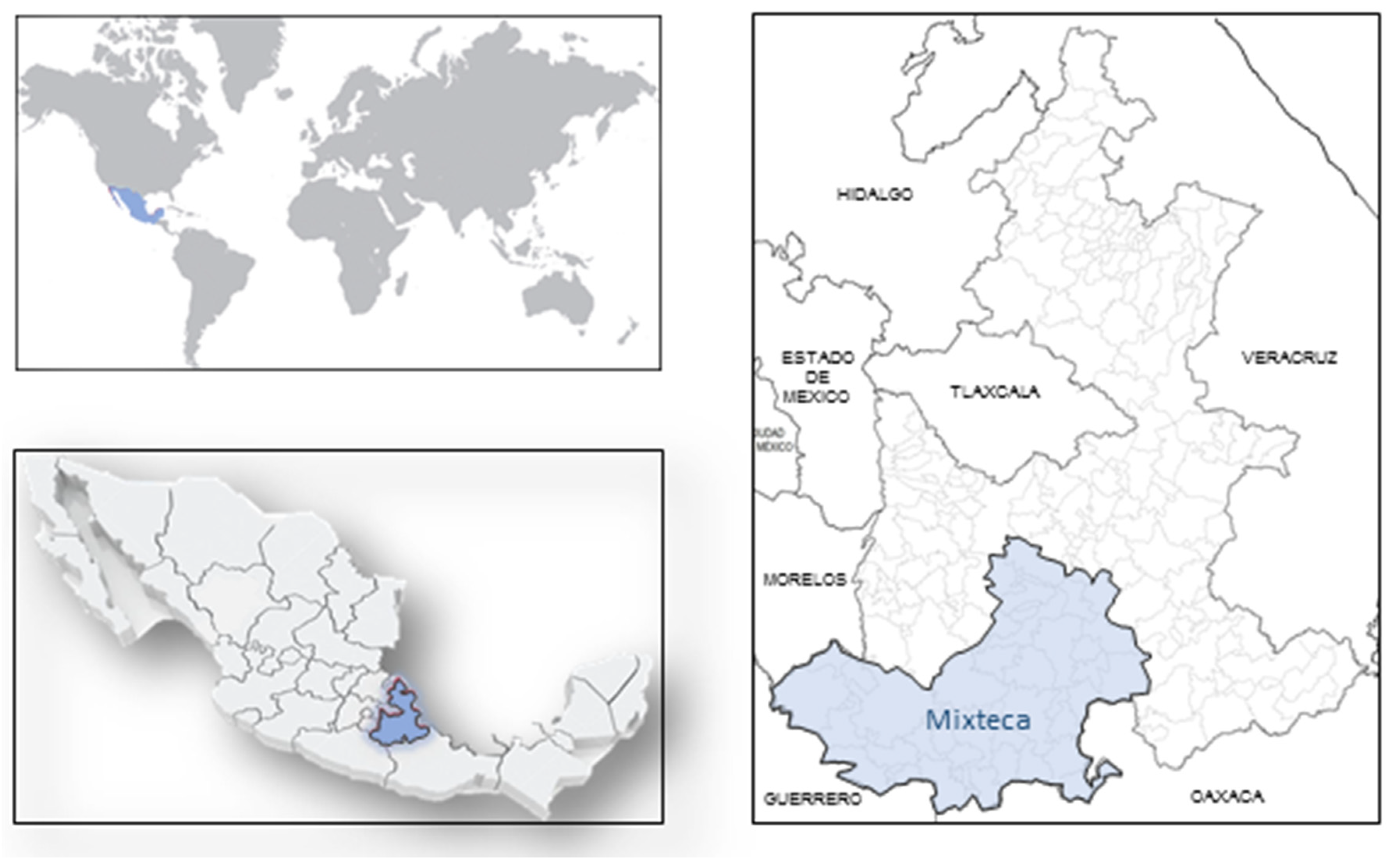
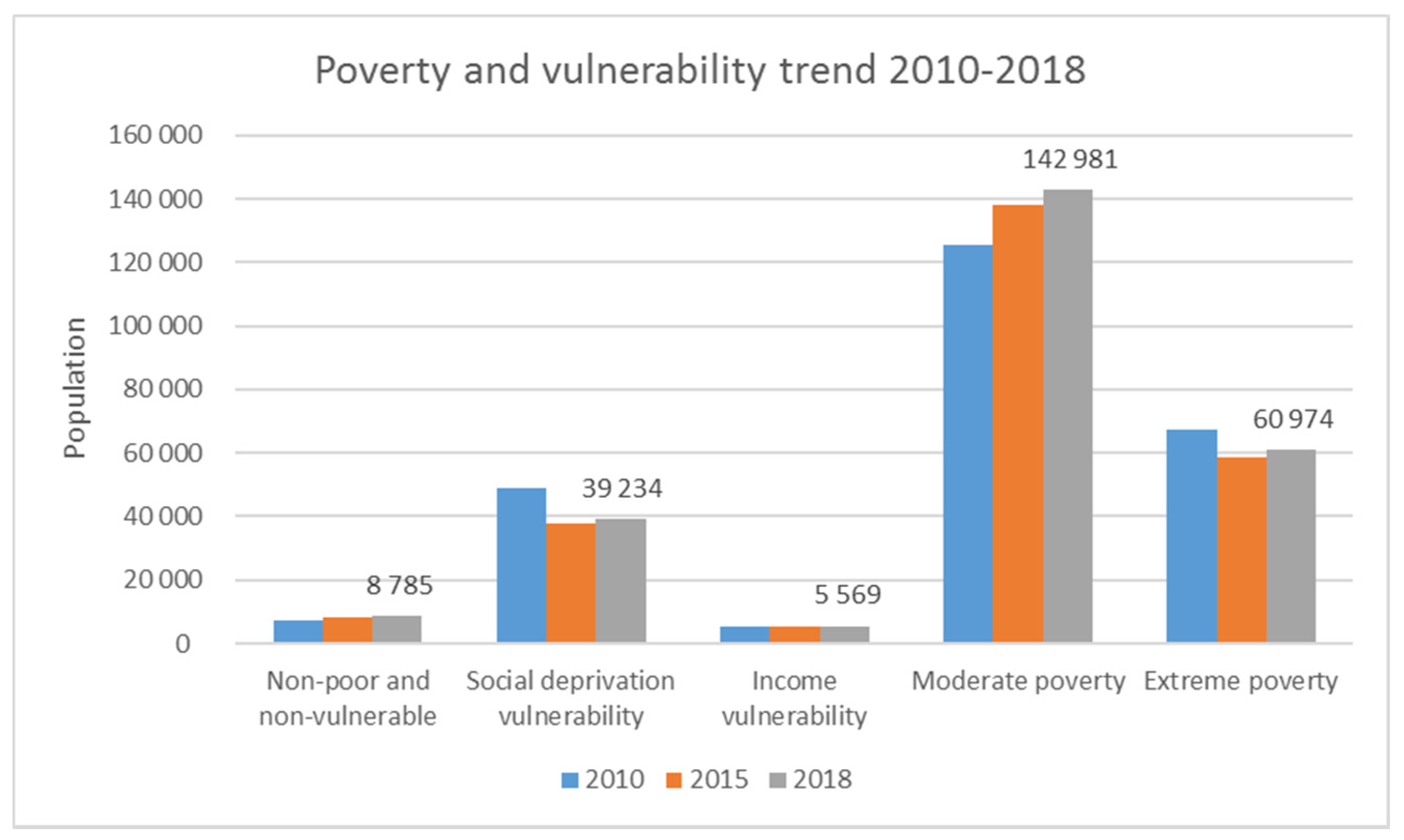

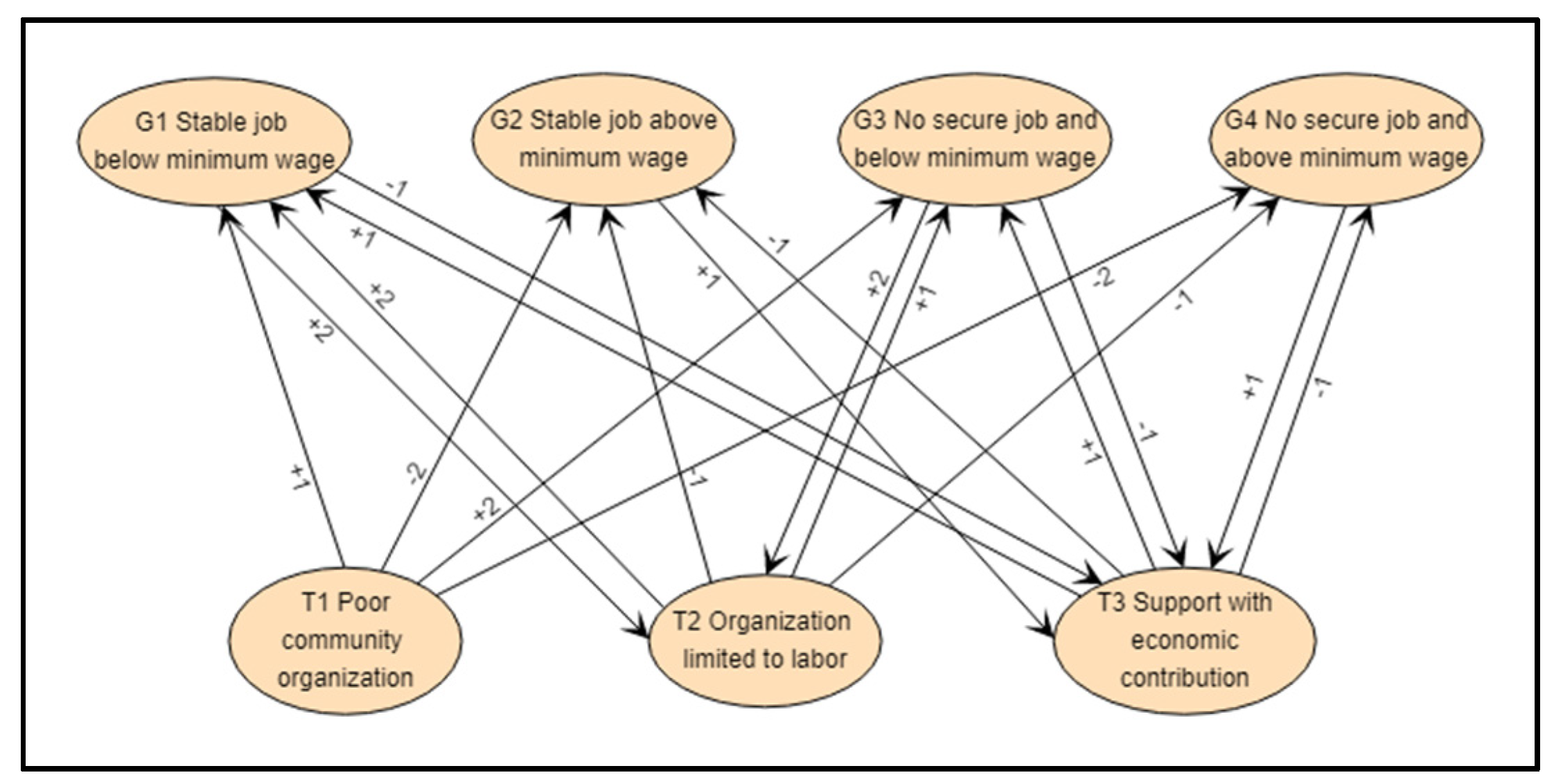
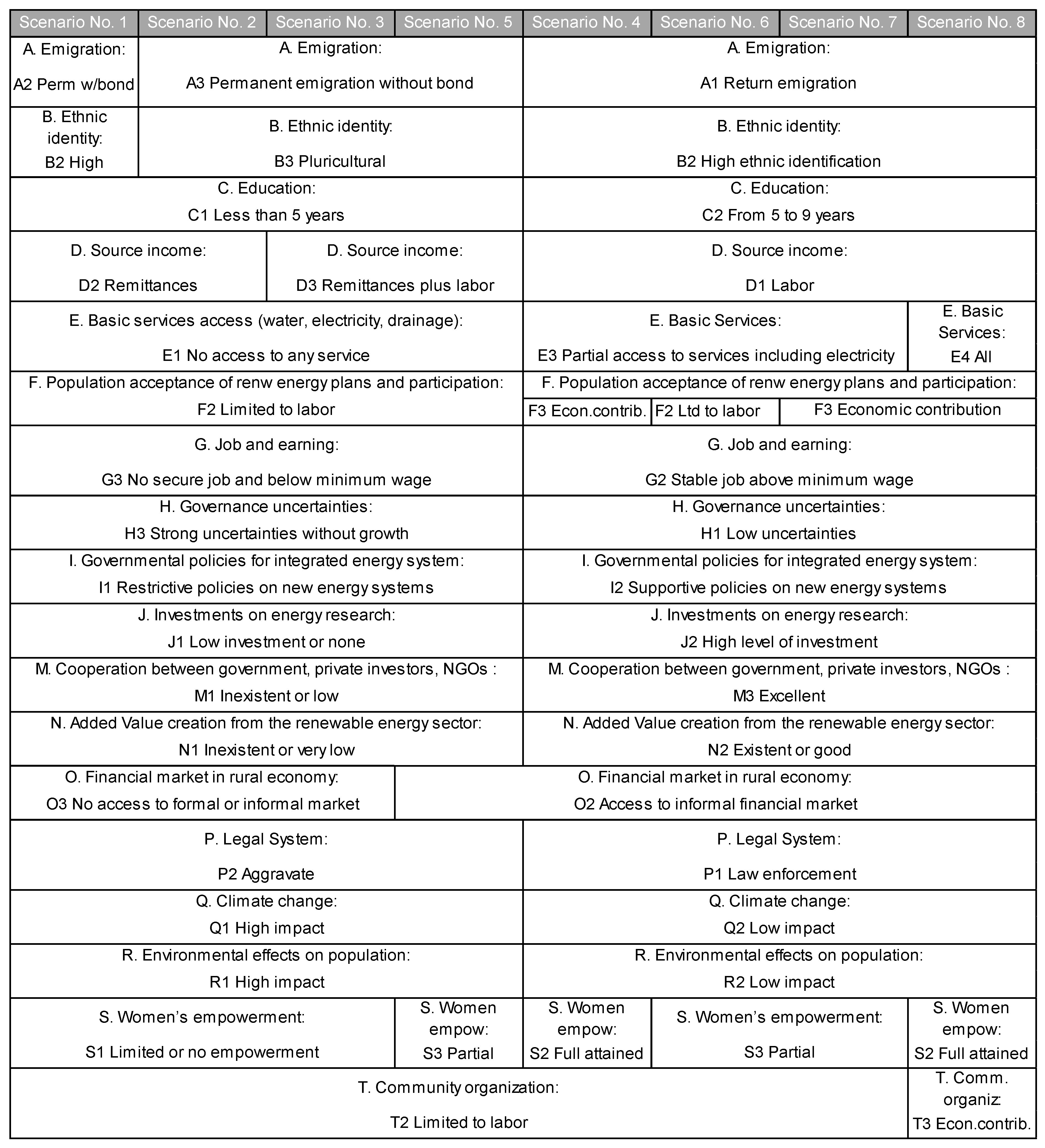
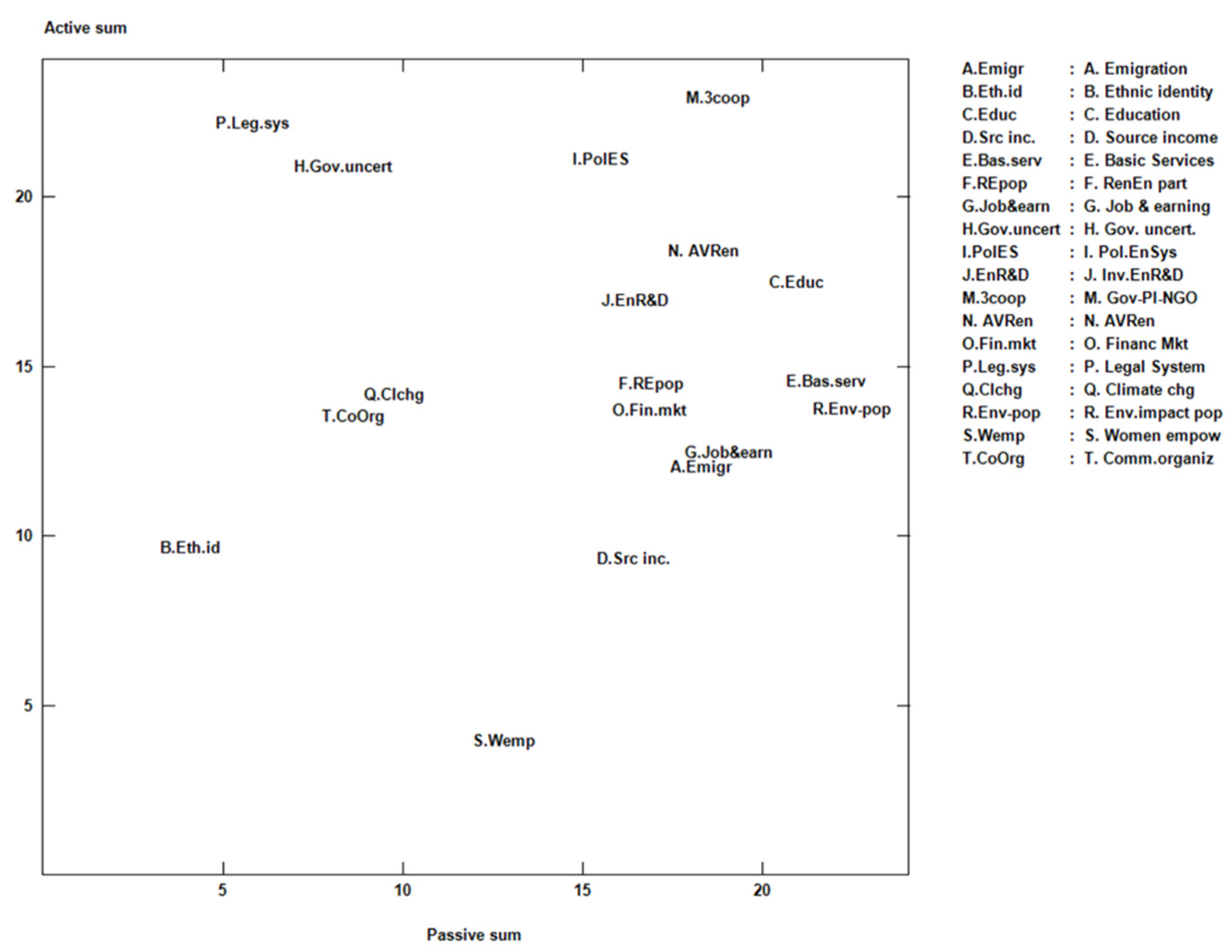
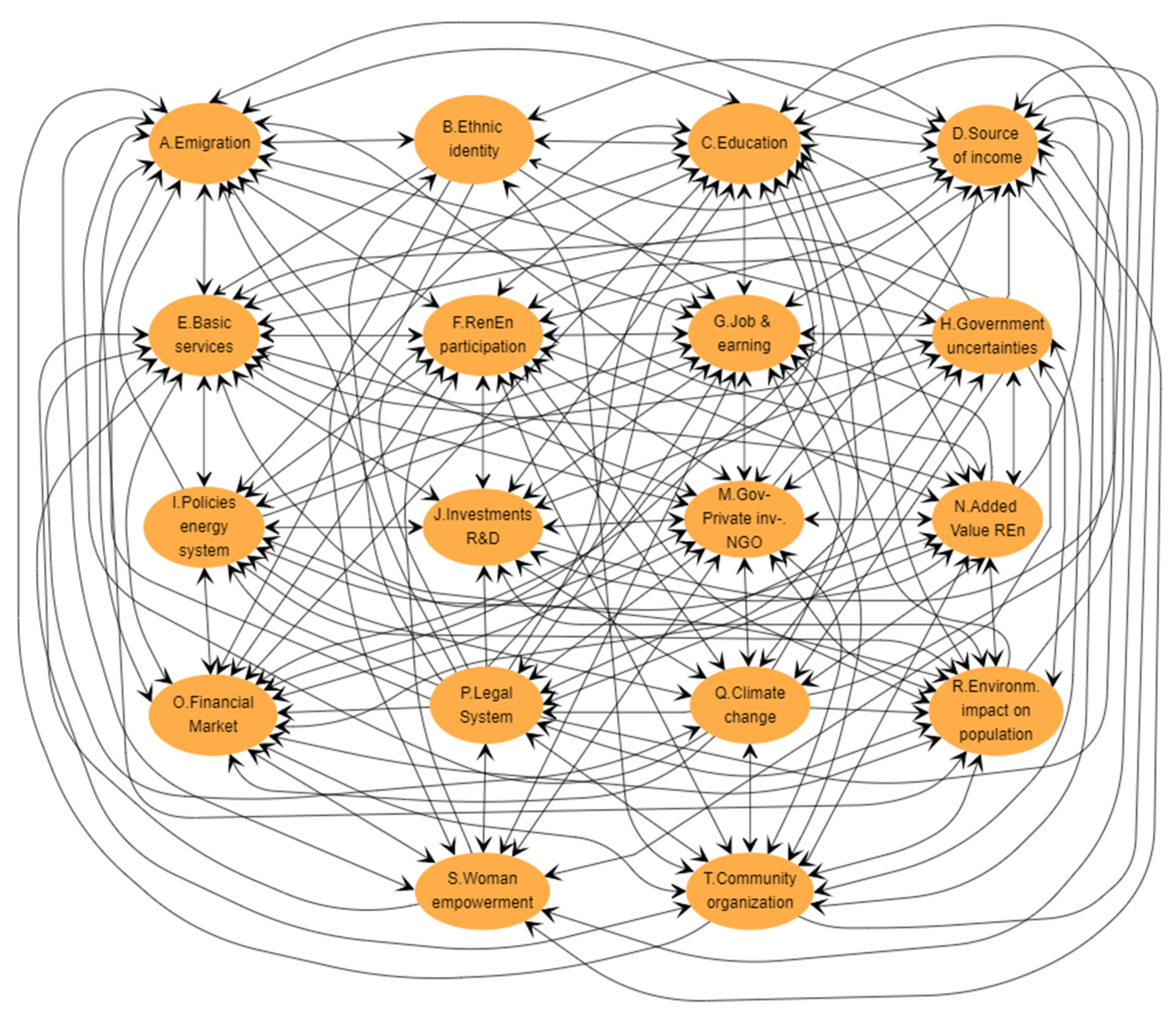
| Descriptor | State 1 | State 2 | State 3 | State 4 |
|---|---|---|---|---|
| A. Emigration | A1 Return emigration | A2 Permanent emigration with bond | A3 Permanent emigration without bond | |
| B. Ethnic identification | B1 Low ethnic identification | B2 High ethnic identification | B3 Pluricultural | |
| C. Education | C1 Less than 5 years | C2 From 5 to 9 years | C3 More than 9 years | |
| D. Source of income | D1 Labor | D2 Remittances | D3 Remittances plus labor | |
| E. Basic services access (water, electricity, drainage) | E1 No access to any service | E2 Partial access to services including water | E3 Partial access to services including electricity | E4 Access to all services |
| F. Population acceptance of renewable energy plans and participation | F1 Poor community organization | F2 Limited to labor | F3 Support includes economic contribution | |
| G. Job and earning | G1 Stable job and min. or below min. wage | G2 Stable job above minimum wage | G3 No secure job and below minimum wage | G4 No secure job and above minimum wage |
| H. Governance uncertainties | H1 Low uncertainties | H2 Strong uncertainties with growth | H3 Strong uncertainties without growth | |
| I. Governmental policies for integrated energy system | I1 Restrictive policies on new energy systems | I2 Supportive policies on new energy systems | ||
| J. Investments on energy research | J1 Low investment or none | J2 High level of investment | ||
| M. Cooperation between government, private investors, NGOs | M1 Inexistent or low | M2 Existent or good | M3 Excellent | |
| N. Added Value creation from the renewable energy sector | N1 Inexistent or very low | N2 Existent or good | ||
| O. Financial market in rural economy | O1 Limited access to formal financial market | O2 Access to informal financial market | O3 No access to formal or informal market | |
| P. Legal System | P1 Law enforcement | P2 Aggravate | P3 Not effectively enforced | |
| Q. Climate change | Q1 High impact | Q2 Low impact | ||
| R. Environmental effects on population | R1 High impact | R2 Low impact | ||
| S. Women’s empowerment | S1 Limited or no empowerment | S2 Full attained | S3 Partial | |
| T. Community organization | T1 Poor community organization | T2 Limited to labor | T3 Support includes economic contribution |
Publisher’s Note: MDPI stays neutral with regard to jurisdictional claims in published maps and institutional affiliations. |
© 2021 by the authors. Licensee MDPI, Basel, Switzerland. This article is an open access article distributed under the terms and conditions of the Creative Commons Attribution (CC BY) license (https://creativecommons.org/licenses/by/4.0/).
Share and Cite
Oviedo-Toral, L.-P.; François, D.E.; Poganietz, W.-R. Challenges for Energy Transition in Poverty-Ridden Regions—The Case of Rural Mixteca, Mexico. Energies 2021, 14, 2596. https://doi.org/10.3390/en14092596
Oviedo-Toral L-P, François DE, Poganietz W-R. Challenges for Energy Transition in Poverty-Ridden Regions—The Case of Rural Mixteca, Mexico. Energies. 2021; 14(9):2596. https://doi.org/10.3390/en14092596
Chicago/Turabian StyleOviedo-Toral, Laura-Patricia, Davi Ezequiel François, and Witold-Roger Poganietz. 2021. "Challenges for Energy Transition in Poverty-Ridden Regions—The Case of Rural Mixteca, Mexico" Energies 14, no. 9: 2596. https://doi.org/10.3390/en14092596
APA StyleOviedo-Toral, L.-P., François, D. E., & Poganietz, W.-R. (2021). Challenges for Energy Transition in Poverty-Ridden Regions—The Case of Rural Mixteca, Mexico. Energies, 14(9), 2596. https://doi.org/10.3390/en14092596






